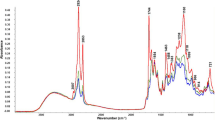Abstract
Plant-based beverages in substitution of milk are used in coffee preparation, the product may be destabilized due to the heating or coffee addition. The aim of this work was to study commercial UHT plant-based beverages applying heat treatment and adding coffee to understand the effects on the physical and thermal stability. Commercial plant-based beverages of five different vegetables sources were analyzed under three conditions: Treatment 0 (25.0 ± 1.5 °C), Treatment 1 (85.0 ± 1.5 °C, 5 min), and Treatment 2 (85.0 ± 1.5 °C, 5 min, instant coffee added). Studied parameters were pH, heat coagulation time (HCT), optical microscope and particle size distribution. The pH ranged from 6.4 to 7.9; HCT between 1 and 13 min; particle size parameters between 65 and 95% (> 1 µm), 1–30% (< 1 µm), 0–2 µm (Dv10), and 10–50 µm (Dv90). The addition of coffee had a significant impact on the pH and the application of Treatment 1 did not have a significant impact in physicochemical stability. It was verified that commercial plant-based beverages are formulated with a large amount of ingredients and cannot be considered clean label. Moreover, the presence of hydrocolloids as ingredients could influence the thermal stability of the samples. Variations in optical microscopy were associated to the vegetable material. It was concluded that the variability of ingredients and the addition of soluble coffee could affects results in the finalization of culinary dishes regarding sensory or nutritional characteristics.




Similar content being viewed by others
References
Sethi S, Tyagi SK, Anurag RK (2016) Plant-based milk alternatives an emerging segment of functional beverages: a review. J Food Sci Technol 53:3408–3423. https://doi.org/10.1007/s13197-016-2328-3
Arbach CT, Alves IA, Serafini MR et al (2021) Recent patent applications in beverages enriched with plant proteins. npj Sci Food. https://doi.org/10.1038/s41538-021-00112-4
Mello LO, d’Almeida FJ, de Costa J, C da, et al (2021) Comparação da composição, dos aspectos nutricionais e do preço de mercado entre o leite UHT e bebidas vegetais UHT. Res Soc Dev 10:e128101320860. https://doi.org/10.33448/rsd-v10i13.20860
Munekata PES, Domínguez R, Budaraju S et al (2020) Effect of innovative food processing technologies on the physicochemical and nutritional properties and quality of non-dairy plant-based beverages. Foods 9:1–16. https://doi.org/10.3390/foods9030288
Aydar EF, Tutuncu S, Ozcelik B (2020) Plant-based milk substitutes: Bioactive compounds, conventional and novel processes, bioavailability studies, and health effects. J Funct Foods 70:103975. https://doi.org/10.1016/j.jff.2020.103975
Zakidou P, Varka EM, Paraskevopoulou A (2022) Foaming properties and sensory acceptance of plant-based beverages as alternatives in the preparation of cappuccino style beverages. Int J Gastron Food Sci 30:100623. https://doi.org/10.1016/j.ijgfs.2022.100623
de Guimarães ÍCO, da Leão MHMR, Pimenta CJ et al (2012) Desenvolvimento e descrição de doce de leite light funcional com café. Cienc e Agrotecnol 36:195–203. https://doi.org/10.1590/S1413-70542012000200008
Karlsson MA, Langton M, Innings F et al (2019) Changes in stability and shelf-life of ultra-high temperature treated milk during long term storage at different temperatures. Heliyon. https://doi.org/10.1016/j.heliyon.2019.e02431
Padula CCGB, Coutinho APC, Battaglini NMP (2020) Elaboração e caracterização físico-química de bebidas saborizadas a base de quirera de arroz e soja. Brazilian J Dev 6:39825–39833. https://doi.org/10.34117/bjdv6n6-501
Lima JR, Bruno LM, Wurlitzer NJ et al (2021) Cashew nut-based beverage: development, characteristics and stability during refrigerated storage. Food Sci Technol 41:60–64. https://doi.org/10.1590/fst.33819
Padma M, Jagannadarao PVK, Edukondalu L et al (2018) Physico-chemical analysis of milk prepared from broken rice. Int J Curr Microbiol Appl Sci 7:426–428. https://doi.org/10.20546/ijcmas.2018.702.054
Rincon L, Braz Assunção Botelho R, de Alencar ER (2020) Development of novel plant-based milk based on chickpea and coconut. Lwt 128:109479. https://doi.org/10.1016/j.lwt.2020.109479
Jeske S, Zannini E, Arendt EK (2017) Evaluation of physicochemical and glycaemic properties of commercial plant-based milk substitutes. Plant Foods Hum Nutr 72:26–33. https://doi.org/10.1007/s11130-016-0583-0
An K, Kang H, Tian D (2019) Stabilization of soy milk using konjac glucomannan. Emirates J Food Agric 31:526–534. https://doi.org/10.9755/ejfa.2019.v31.i7.1964
Mäkinen OE, Uniacke-Lowe T, O’Mahony JA, Arendt EK (2015) Physicochemical and acid gelation properties of commercial UHT-treated plant-based milk substitutes and lactose free bovine milk. Food Chem 168:630–638. https://doi.org/10.1016/j.foodchem.2014.07.036
Manzoor MF, Ahmad N, Aadil RM et al (2019) Impact of pulsed electric field on rheological, structural, and physicochemical properties of almond milk. J Food Process Eng 42:1–11. https://doi.org/10.1111/jfpe.13299
Huang X, Kakuda Y, Cui W (2001) Hydrocolloids in emulsions: particle size distribution and interfacial activity. Food Hydrocoll 15:533–542. https://doi.org/10.1016/S0268-005X(01)00091-1
Gama AP, Hung YC, Adhikari K (2019) Optimization of emulsifier and stabilizer concentrations in a model peanut-based beverage system: a mixture design approach. Foods. https://doi.org/10.3390/foods8040116
Francisquini JDA, Altivo R, Diaz CCM, da Costa JC, Kharfan D, Stephani R, Perrone IT (2023) Physicochemical aspects of industrial plant-based beverages. Química Nova. https://doi.org/10.21577/0100-4042.20230089
Acknowledgements
The authors are thankful for the support from the National Council for Scientific and Technological Development (CNPq) with the support grants [307334/2020-1] and [317190/2021-0] the support grants from the academic doctorate of innovation [403602/2020-3] DAI Program-CNPq and postdoctoral support CNPq-PDE [402339/2022-3]. We also appreciate the Coordination for the Improvement of Higher Education Personnel (CAPES), grant number [001], and John Bean Technologies Máquinas e Equipamentos Industriais Ltda. The authors declare no conflicts of interest.
Funding
This study was funded by National Council for Scientific and Technological Development (CNPq) and the Coordination for the Improvement of Higher Education Personnel (CAPES).
Author information
Authors and Affiliations
Corresponding author
Ethics declarations
Conflict of interests
The authors declare they have no financial interests.
Compliance with ethics requirements
This article does not contain any studies with human or animal subjects.
Additional information
Publisher's Note
Springer Nature remains neutral with regard to jurisdictional claims in published maps and institutional affiliations.
Rights and permissions
Springer Nature or its licensor (e.g. a society or other partner) holds exclusive rights to this article under a publishing agreement with the author(s) or other rightsholder(s); author self-archiving of the accepted manuscript version of this article is solely governed by the terms of such publishing agreement and applicable law.
About this article
Cite this article
Francisquini, J.d., Altivo, R., Diaz, C.C.M. et al. Physicochemical analysis of thermally treated commercial plant-based beverages coffee added. Eur Food Res Technol 249, 3191–3199 (2023). https://doi.org/10.1007/s00217-023-04359-x
Received:
Revised:
Accepted:
Published:
Issue Date:
DOI: https://doi.org/10.1007/s00217-023-04359-x




